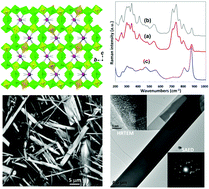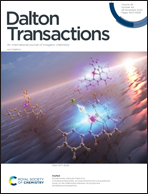Uranyl oxide hydrate frameworks with lanthanide ions†
Abstract
Two uranyl oxide hydrate frameworks (UOFs) incorporating either Eu(III) or Gd(III) ions were synthesized hydrothermally and structurally studied. The uranyl oxide hydroxide layers similar to those in β-U3O8 with both tetragonal and pentagonal bipyramidal uranium polyhedra are connected with pairs of pentagonal bipyramidal uranium polyhedra through uranyl cation–cation interactions to form three-dimensional frameworks with Eu(III) or Gd(III) ions inside the channels. Both SEM and TEM examinations revealed needle crystal morphologies and a U:Eu/Gd ratio of 5.5, with the TEM-SAED pattern indexed to the orthorhombic crystal structure C2221, as also determined using synchrotron single-crystal X-ray diffraction. Raman spectroscopy revealed the band splitting of uranyl symmetric stretching vibrations, reflecting the presence of a unique pentavalent uranium centre in octahedral coordination geometry. The presence of pentavalent uranium in both UOFs was confirmed with diffuse reflectance spectroscopy. Given that layer-structured uranyl oxide hydroxy hydrate phases are dominant for both light and heavy lanthanide ions under similar reaction conditions, the ionic radius plays an important role in controlling the structure types, with UOFs formed only for Eu(III) and Gd(III) ions in the lanthanide series. These new UOFs with lanthanide ions may have various implications especially in nuclear materials.



 Please wait while we load your content...
Please wait while we load your content...